CTIA Wireless 2003
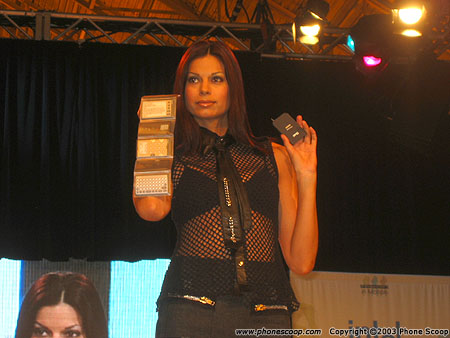
"Alvissâ„¢": a set of concept devices by Sanyo. Each is the size of a credit card and serves a different function. They all communicate via Bluetooth and "PMG" software from IXI Mobile.

A wearable computer concept with a heads-up display. Didn't catch the company, but it looks kind of cool. (And I didn't want the ladies to feel left out.)
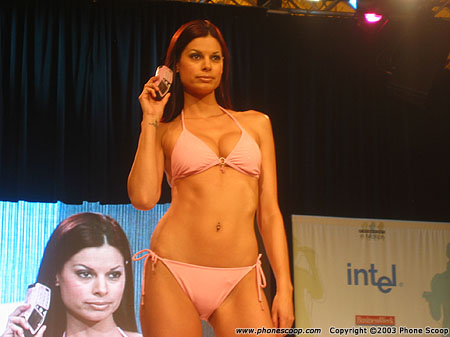
The Wildseed (Kyocera Kurv) phone.

The Motorola Bluetooth headset and Push-To-Talk button from the Frog Design wearables concept.

A close-up of the Motorola / Frog Design wearables concept.
By the time I met with Kyocera, I was running a bit short on time, so I don't have any photos from the meeting, but there are a few from MobileFocus in the Preview report. Most of Kyocera's lineup is pretty straightforward, but there are a few tidbits I learned that are worth passing on.
First, the highly-anticipated 7135 has finally been approved by Verizon, and should be available from Verizon's business channels and the Kyocera web site the week after the show, and through Verizon's consumer channels a couple weeks later. Also, Kyocera has been working with Veo to get their SDIO camera working on the 7135.
The Wildseed phone - AKA the Kyocera Kurv - is definitely a promising product, but I was disappointed by its size. It's a bit large, and especially thick. If they could shave a third off the thickness, I think it would be great. But at its current size, I think it's only a matter of time before people start calling it a "brick" phone. Some good news is that - in response to focus-group feedback - Kyocera has decided to add a camera, BREW, FM radio, MP3 playback, and MMS-like functionality to the design. But the bad news is that these changes will push the release back to the 4th quarter, and they don't expect to reduce the size in that time. I have to wonder if they're just trying to pack too much into this thing, at the expense of actually shipping something.
The SE47 "Slider" is probably the most unexpected and interesting product in the Kyocera's new lineup. MVNO Virgin Mobile will be offering it, and it is currently being considered for the honor of being the first official "MTV Phone". It's definitely a distinctive design, and it has a good mix of features to back it up.
One thing that's been bothering me recently is that Kyocera doesn't seem to transfer much of its handset expertise from Japan to the U.S. Kyocera's Japanese handsets blow away anything they've announced here - by a wide margin. Competitors such as Sharp and Sanyo are set to trounce Kyocera if they don't act quickly. Also, I was disappointed that the Kurv was the only camera phone in Kyocera's lineup.
So I asked the hard questions: "Why doesn't Kyocera seem to be very good at technology transfer from its own divisions in Japan? And why no camera phones?" The answer to both questions was simple. They definitely feel the heat from companies like Sanyo, and they are working aggressively to improve internal cooperation, to bring more technology from their Asian divisions to the U.S. market. The Slider marks the start of that increased technology transfer. It will culminate in Q1 next year with an industry-leading entry into the U.S. camera-phone market. I can't share everything I was told, but I can tell you I'm pretty excited by what I heard. Kyocera may be falling behind at the moment, but a big rebound seems to be right around the corner.
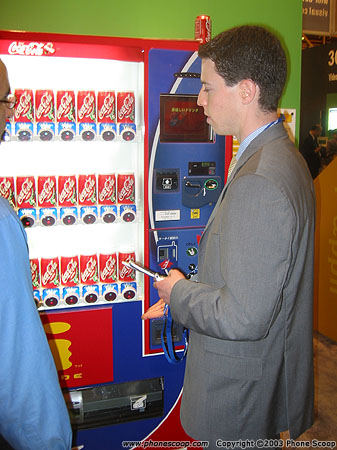
The "cMode" Coke machine at the DoCoMo booth. DoCoMo had a semi-large booth showing all the cool stuff they have in Japan. It's all very cool stuff, but Japan has mostly been eclipsed by Korea in mobile technology these days, and as I mentioned, companies like Sanyo are bringing Japanese technology to the U.S. faster then ever before. So DoCoMo's latest isn't nearly as far-out and impressive as it used to be.
As I mentioned in the Nokia bit earlier, Push-To-Talk (PTT), was definitely one of the major buzzwords for the show. One pioneer in this field is Mobile Tornado. Recently they partnered with Comverse. Mobile Tornado brings their PTT software to the table, while Comverse provides the back-end hardware and sales force.
Like most of the hottest new PTT technologies, Mobile Tornado's system is interoperable among several types of systems, including CDMA 1xRTT, GPRS, and Wi-Fi (802.11b). Unlike other systems, (as far as I can tell,) Mobile Tornado's system even interoperates with iDEN, which is pretty cool. For example, a CDMA carrier using Mobile Tornado's solution could theoretically link up with Nextel's system and let customers use PTT between the two networks.
Of course he was just a wee bit biased, but the Mobile Tornado rep was quick to point out the flaws in competing systems. According to him, other systems guzzle battery life, can't support more than a few thousand users, and completely tie up the phone during a PTT session. Mobile Tornado's system, meanwhile, can support up to two million users, is frugal with battery life, and supports full PTT call-waiting. I didn't have time to run those claims by the other companies, though, so take that all with a grain of salt. Mobile Tornado's system can support such a large number of users because it can handle local one-to-one sessions in a peer-to-peer fashion. Only long-distance and one-to-many sessions require the involvement of a server, and those usually make up only five percent of all PTT calls.
Like Nokia's system, Mobile Tornado's phone software must be embedded in the phone. It can't be added to existing phones via Java or BREW. They do, however, have client software for PDAs, which they were demonstrating the system on a couple of iPAQs over Wi-Fi.
The phone demo used two modified Samsung SPH-N400s running on the Sprint PCS network. (Hmmm...) It was pretty quick, with latency around one second. Not as fast as iDEN (Nextel), but pretty darn good compared to the rest of the competition. I was impressed.
While quick to dismiss most competing systems, the Mobile Tornado rep had nothing but good things to say about QChat, Qualcomm's PTT solution for CDMA. Apparently QChat would have blown everything else out of the water - if Nextel hadn't snatched up an exclusive U.S. license to the technology. Clearly, it was a smart move for Nextel, but it is a bit frustrating that the best PTT technology for CDMA may never be deployed in the U.S. (Unless Nextel switches to CDMA, or Verizon or Sprint buys Nextel.)
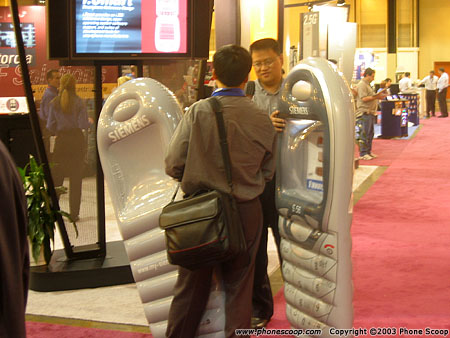
Siemens was giving away inflatable pool floats in the shape of a giant S56. They were only giving them away inflated, so plenty of people were walking around with huge inflated S56s. I thought it was a pretty clever promotional stunt.
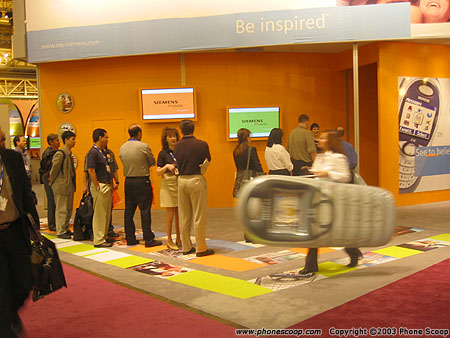
This is the line of people waiting to get their super-size S56. Throughout the show, their was a halo of people around the Siemens booth desperately trying to deflate them. Thankfully, as a member of the press, I was able to get one uninflated. :-)


 iPhone 14 Plus Offers a Big Screen For Less
iPhone 14 Plus Offers a Big Screen For Less
 Samsung S24 Series Adds More AI, Updates the Hardware
Samsung S24 Series Adds More AI, Updates the Hardware
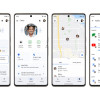 Google Overhauls Android's Parental Controls
Google Overhauls Android's Parental Controls
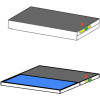 Foldable Google Pixel Confirmed by FCC
Foldable Google Pixel Confirmed by FCC
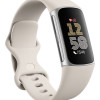 Google's New Fitbit Blurs the Line Between Tracker and Smartwatch
Google's New Fitbit Blurs the Line Between Tracker and Smartwatch

